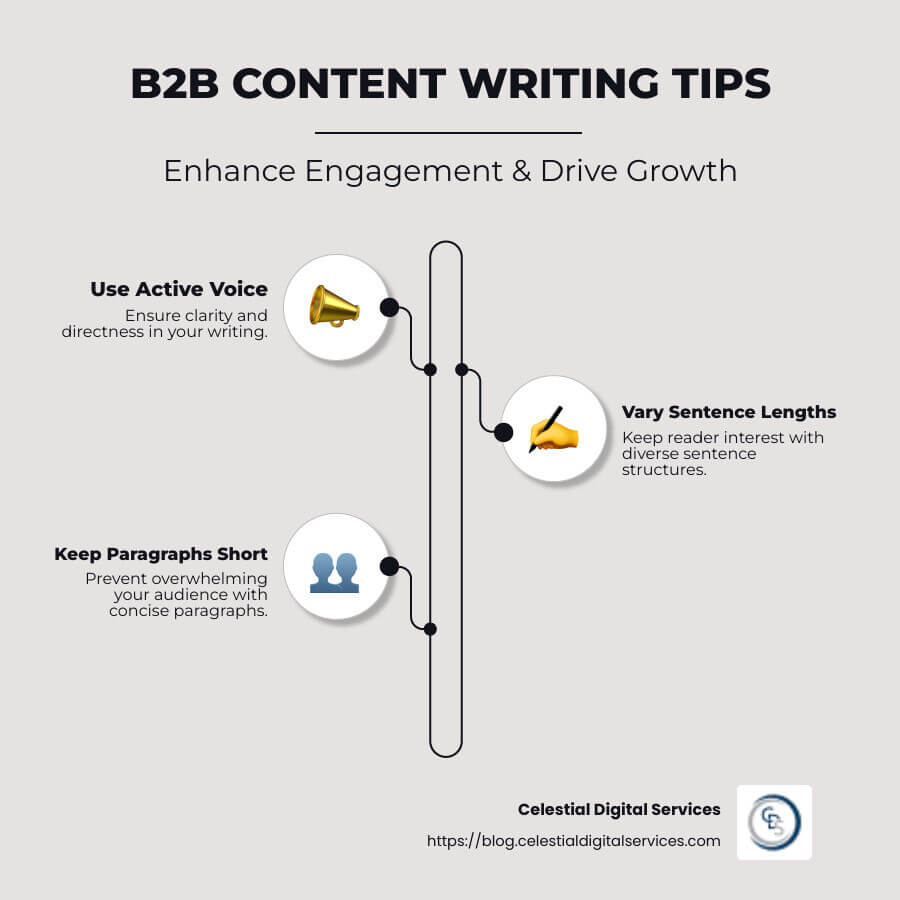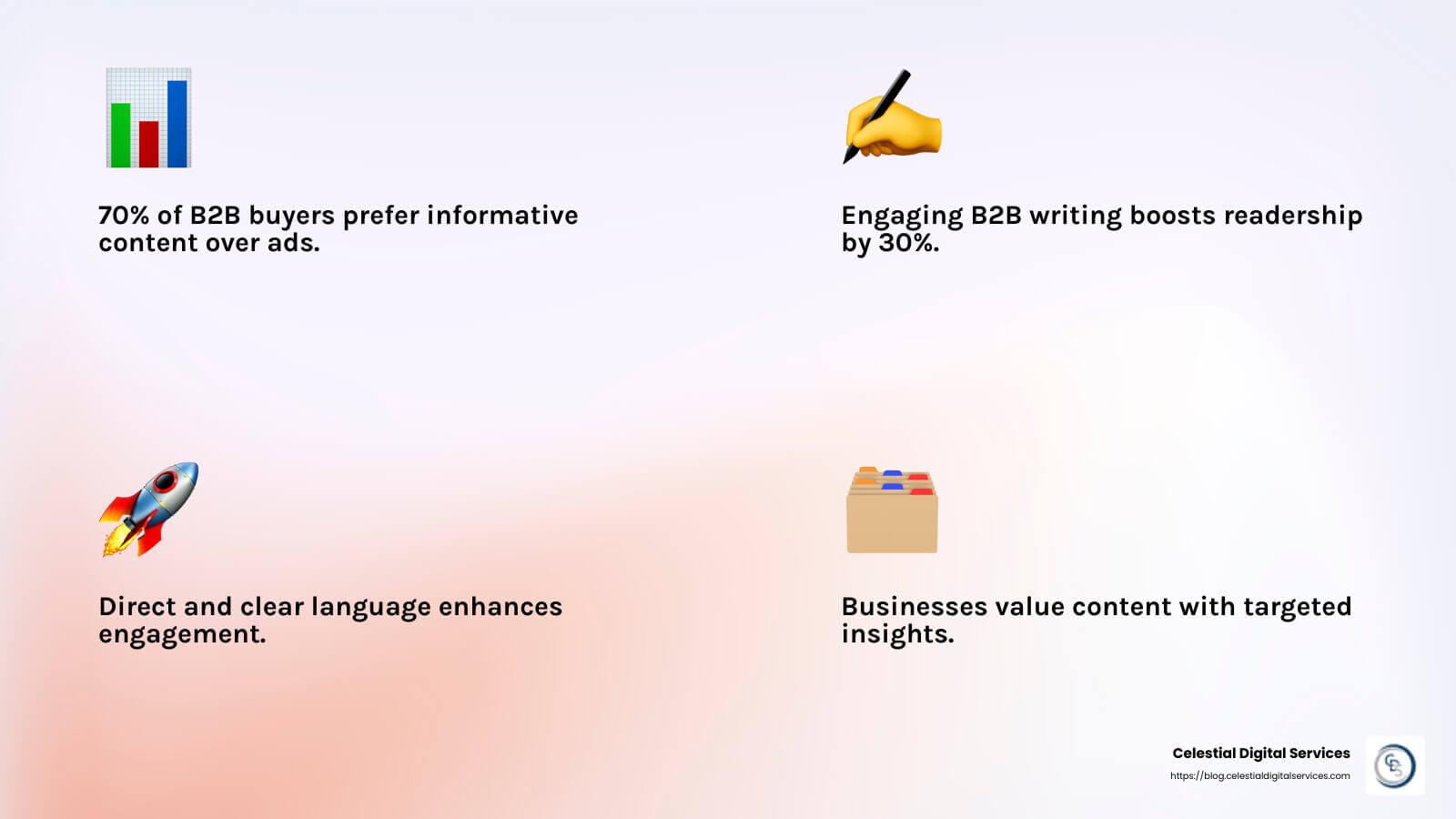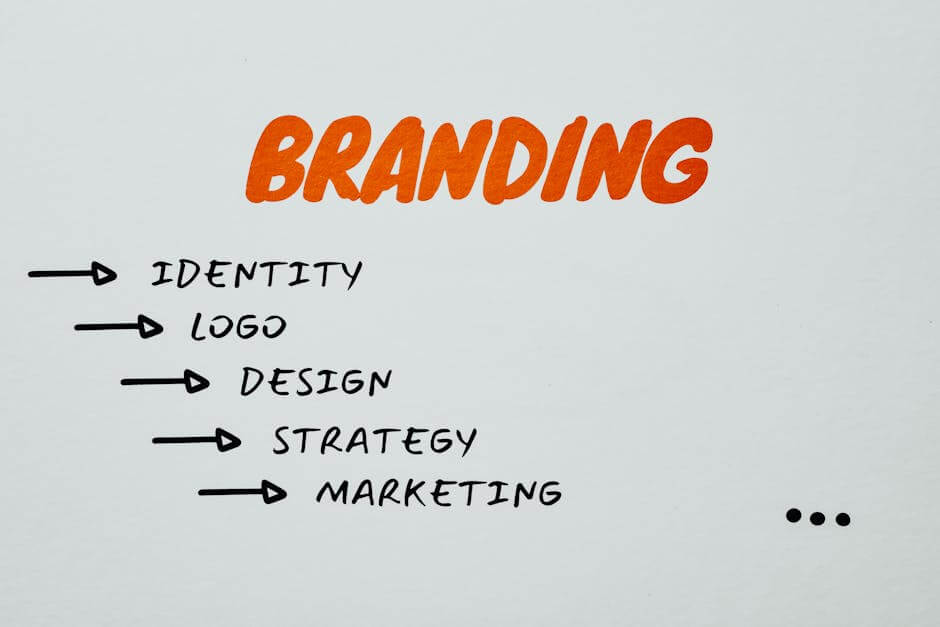B2B content writing tips are crucial for businesses aiming to improve audience engagement and drive growth. If you’re looking to up your B2B writing game, here are some quick strategies:
- Use an active voice for clarity and directness.
- Vary sentence lengths to maintain reader interest.
- Keep paragraphs short to avoid overwhelming your audience.
- Speak directly to readers to make the content relatable.
- Integrate action words to motivate and engage.
In a competitive B2B landscape, understanding the nuances of audience engagement isn’t just beneficial—it’s essential for success.
With over a decade in digital marketing, I specialize in crafting clear, authoritative content that resonates with B2B audiences. Leveraging my experience, including strategies like those above, can significantly improve the effectiveness of your content. Now, let’s dig deeper into the art of B2B writing and audience connection.

Understanding B2B Content Writing
When it comes to B2B content writing, understanding the unique style, audience, and purpose is key to crafting impactful content that resonates with other businesses.
B2B Writing Style
B2B writing is often more formal and data-driven compared to B2C writing. However, this doesn’t mean it has to be dull. The modern B2B style has evolved to be more engaging and informative, focusing on clarity and directness.
- Active Voice: Use an active voice to create a direct and engaging tone. This helps maintain clarity and keeps the reader’s attention.
- Conciseness: Get to the point quickly. B2B readers appreciate content that respects their time and delivers information efficiently.
- Technical Jargon: While some industry-specific terms are necessary, avoid overloading your content with jargon. Aim for language that is accessible to a broad business audience.
Audience
The audience for B2B content is typically other businesses, including business owners, marketers, and decision-makers. Understanding their needs and preferences is crucial.
- Targeted Content: Tailor your content to address the specific challenges and interests of your audience. This could involve industry-specific insights or solutions to common business problems.
- Decision-Makers: You’re often writing for individuals who make purchasing decisions. Provide them with the information they need to make informed choices.
Purpose
The primary purpose of B2B content is to educate, inform, and persuade other businesses. It aims to build trust and establish your company as a thought leader in your industry.
- Problem-Solving: Offer solutions to common industry challenges. Case studies and whitepapers are excellent formats for demonstrating how your products or services can solve specific problems.
- Building Authority: Use data and expert insights to establish your brand as a reliable source of information. This not only builds trust but also encourages potential clients to consider your offerings.

In summary, successful B2B content writing requires a balance of professionalism and engagement. By focusing on a clear style, understanding your audience, and defining your purpose, you can create content that not only informs but also persuades and builds long-term business relationships.
Now, let’s explore the top formats for B2B content that can help you achieve these goals.
B2B Content Writing Tips
To lift your B2B content writing game, focus on three key areas: quality, planning, and technicalities. Mastering these elements will help you craft content that resonates with your business audience and delivers high returns.
Quality
Quality is the cornerstone of effective B2B content. High-quality content not only informs but also engages and persuades. Here are some tips to ensure your content stands out:
-
Research-Driven: Base your content on thorough research. Use credible sources and data to back up your claims. For instance, case studies can provide a solid foundation for demonstrating your expertise and reliability.
-
Clarity and Precision: Write with clarity and precision. Avoid unnecessary jargon and focus on delivering your message in a straightforward manner. Your audience values their time and appreciates content that gets to the point.
-
Compelling Storytelling: Use storytelling to make your content more relatable and memorable. Real-world examples and anecdotes can illustrate your points effectively and keep your readers engaged.
Planning
Effective planning is crucial to producing consistent and impactful B2B content. Here’s how you can plan your content strategy:
-
Editorial Calendar: Develop an editorial calendar to organize your content creation process. This will help you maintain a consistent publishing schedule and ensure that your content aligns with your business goals.
-
Target Audience: Understand your target audience’s needs, preferences, and pain points. Tailor your content to address these aspects and provide solutions that resonate with them.
-
Content Goals: Define clear goals for each piece of content. Whether it’s lead generation, brand awareness, or customer education, having a specific objective will guide your writing and ensure your content is purposeful.
Technicalities
Addressing the technical aspects of B2B content writing can improve its effectiveness and reach. Consider these technical tips:
-
SEO Optimization: Optimize your content for search engines by incorporating relevant keywords and phrases. This will improve your content’s visibility and attract more organic traffic.
-
Format and Structure: Use headings, bullet points, and short paragraphs to make your content easy to read and digest. This not only improves readability but also helps your audience quickly find the information they need.
-
Call-to-Action (CTA): Include a clear and compelling CTA to guide your readers toward the next step. Whether it’s signing up for a newsletter or exploring your services, a strong CTA can drive engagement and conversions.

By focusing on quality, planning, and technicalities, you can create B2B content that not only meets but exceeds the expectations of your business audience. Now, let’s explore the top formats for B2B content that can help you achieve these goals.
Top 5 B2B Content Formats
In B2B content, choosing the right format is crucial. Different formats serve different purposes and can help you reach your business audience effectively. Let’s explore the top five B2B content formats that can lift your content strategy.
Blog Posts
Blog posts are an essential tool for establishing credibility and showcasing expertise. They are a great way to engage your audience with valuable insights and information. B2B content writing tips for blog posts include focusing on SEO to reach your target audience effectively. High-quality blog posts, ranging from 1,500 to 3,000 words, can help drive organic traffic to your website and build long-term relationships with your readers.
Case Studies
Case studies are powerful for demonstrating the real-world impact of your products or services. They provide detailed accounts of how your solutions have helped other businesses overcome challenges. By sharing success stories, you build trust and authenticity. A well-crafted case study includes a clear problem, solution, and results, and should be between 500 to 1,500 words.
“Two-thirds of B2B marketers have used case studies in the past year, making them one of the top three content assets.”
White Papers
White papers are comprehensive documents that dig deep into specific topics. They are ideal for educating your audience and establishing thought leadership. While they shouldn’t be overly promotional, they should provide solutions backed by data and expert analysis. White papers typically range from 5 to 20 pages and can be gated to generate leads.
Email Newsletters
Email newsletters are a direct way to engage with your audience and keep them informed. They can include updates, offers, and educational content. Keep them concise, ideally around 200 words, to maximize engagement. The key to successful newsletters is personalization—tailor content to the interests and needs of your subscribers.
Social Media Content
Social media is a dynamic platform for reaching and engaging with your audience. It allows you to share a variety of content types, from short posts to visuals and videos. Understanding each platform’s unique characteristics is vital. Use high-quality images and interactive posts to boost engagement and drive traffic back to your website.
“Visuals are processed 60,000 times faster than text, making them essential for effective social media content.”
By leveraging these top formats, you can create a robust B2B content strategy that resonates with your audience and drives business results. Next, let’s explore how to optimize your B2B content for SEO.
How to Optimize B2B Content for SEO
Optimizing your B2B content for SEO is key to making sure your audience finds you. Let’s explore two crucial elements: keyword research and content optimization tools.
Keyword Research
Finding the right keywords is like open uping a treasure chest of opportunities. It helps your content appear in search results when potential clients are looking for what you offer. Start by using tools like Semrush’s Keyword Magic Tool to identify relevant keywords. Enter a broad topic related to your industry, and see what comes up.
Look at two important columns: Volume and KD % (Keyword Difficulty). High volume means more people are searching for that term. Lower KD % indicates it’s easier to rank for that keyword. Aim for a balance between these two metrics to maximize your reach.
Tip: Regularly update your keyword list every 3-6 months to stay aligned with changing trends.
Content Optimization Tools
Once you have your keywords, it’s time to craft content that stands out. Here, content optimization tools can be your best friends. The SEO Writing Assistant is a great option. It checks your text for readability, tone of voice, and SEO effectiveness.
This tool even suggests additional keywords and ensures your content maintains a consistent voice. If you’re stuck, the “Smart Writer” AI feature can help you rewrite sections to improve clarity and engagement.
Did you know? Using clear and concise language not only improves readability but also keeps readers engaged longer.
Before hitting publish, remember to write a catchy title tag and meta description. These should be optimized for mobile to prevent truncation. Aim for a title tag of 50 to 60 characters and a meta description around 105 characters.
By focusing on these elements, you can ensure your B2B content not only reaches your audience but also resonates with them. Next, we’ll answer some frequently asked questions about B2B content writing.
Frequently Asked Questions about B2B Content Writing
How to be a B2B content writer?
Becoming an expert in B2B content writing starts with understanding your audience and mastering the art of keyword research. Keyword research is essential because it helps you know what your audience is searching for. Use tools like Semrush to find keywords that align with your business goals. Choose keywords with a good balance of search volume and competitiveness.
Your writing style should be clear and concise. Avoid jargon unless your audience understands it. Write like you’re having a conversation with your reader. Short paragraphs and simple words can make your content more engaging.
Pro Tip: Always keep a content calendar to plan your topics. This helps you stay organized and consistent.
What makes good B2B content?
Good B2B content is about building audience loyalty and solving problems. Your content should offer valuable insights and practical solutions to your audience’s challenges. This builds trust and positions your brand as an industry leader.
Engaging content often includes stories or case studies. These elements make your writing relatable and memorable. According to research, adding stories can improve reader engagement by making complex topics easier to understand.
Fact: 58% of buyers find content hollow if it doesn’t address their pain points. Make sure your content is relevant and meaningful.
What is the biggest challenge in writing for B2B brands?
A challenge is achieving content recognition and making a real impact. The digital space is crowded, and standing out requires creativity and strategy. Your content must be unique and custom to your audience’s needs.
Another challenge is measuring the impact of your content. Use analytics to track engagement and conversion rates. This data helps you refine your strategy and improve your content’s effectiveness.
Insight: Regularly testing your content strategy can reveal what works best. Don’t hesitate to experiment with different formats and styles to find what resonates with your audience.
Next, we’ll wrap up with how Celestial Digital Services can help lift your B2B content game.
Conclusion
At Celestial Digital Services, we are passionate about helping startups and local businesses thrive in the competitive online landscape. Our mission is to empower small enterprises through innovative digital solutions. With our range of services, including SEO, lead generation, social media marketing, mobile app development, chatbot services, and AI-based tools, we position ourselves as a reliable partner for businesses looking to improve their online presence.
Our focus is on simplifying digital marketing for those who may not be technically inclined. We understand that digital marketing can be overwhelming, and that’s why we tailor our solutions to meet your specific needs. Whether you’re looking to improve your website’s visibility, generate high-quality leads, or engage your audience on social media, we have the expertise to guide you every step of the way.
By leveraging our B2B content writing tips, you can create content that not only attracts but also retains your target audience. Good content is about building trust and offering solutions. When your audience sees you as a problem-solver, they’ll keep coming back for more.
Ready to take your B2B content game to the next level? Explore our blog for more insights and tips on how to lift your digital marketing strategy.
Together, let’s innovate, inform, and inspire.





